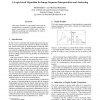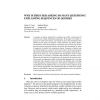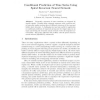IJCAI
2003
15 years 2 months ago
2003
This paper describes a logic-based framework for interpretation of sequences of scenes captured by a stereo vision system of a mobile robot. An algorithm for anchoring and interpr...
109
click to vote
DBSEC
2004
15 years 2 months ago
2004
A sequence of queries submitted by a database user within a short period of time may have a single, illuminating explanation. In this paper we consider sequences of single-record q...
114
click to vote
AAAI
2004
15 years 2 months ago
2004
Learning reusable sequences can support the development of expertise in many domains, either by improving decisionmaking quality or decreasing execution speed. This paper introduc...
107
click to vote
MVA
2007
15 years 2 months ago
2007
We introduce an algorithm for synchronizing two video sequences recorded by stationary cameras. It extends common RANSAC-based approaches that recover either a homography or a fun...
ESANN
2008
15 years 2 months ago
2008
Frequently, sequences of state transitions are triggered by specific signals. Learning these triggered sequences with recurrent neural networks implies storing them as different at...
124
Voted
BIOCOMP
2007
15 years 2 months ago
2007
Low-Complexity Regions (LCRs) of biological sequences are the main source of false positives in similarity searches for biological sequence databases. We consider the problem of ï...
107
click to vote
COMPSAC
2008
IEEE
15 years 2 months ago
2008
IEEE
During software development and evolution activities, the developers focus the refactoring efforts on choosing and applying refactoring patterns (or sequences of patterns) that ar...
108
Voted
GCB
2006
Springer
15 years 4 months ago
2006
Springer
: Despite many years of research on how to properly align sequences in the presence of sequencing errors, alternative splicing and micro-exons, the correct alignment of mRNA sequen...
132
click to vote
EUROCODE
1990
15 years 5 months ago
1990
: This paper deals with the effect of bit change errors on the linear complexity of finite sequences. Though a change in a single bit can cause a large change in linear complexity,...
RECOMB
1997
Springer
15 years 5 months ago
1997
Springer
A progressive alignment algorithm produces a multi-alignment of a set of sequences by repeatedly aligning pairs of sequences and/or previously generated alignments. We describe a ...






